Storage of food
Download as pptx, pdf2 likes283 views
AGA UMAR TARIQ
1 of 33
Download to read offline
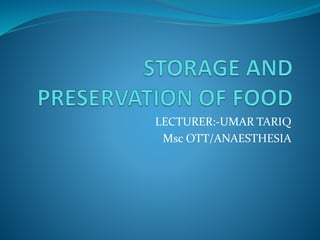
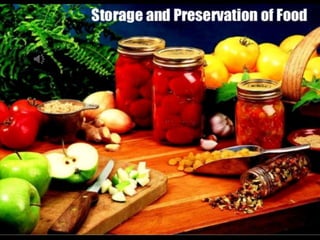
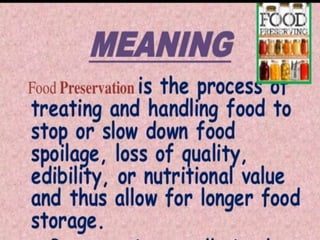


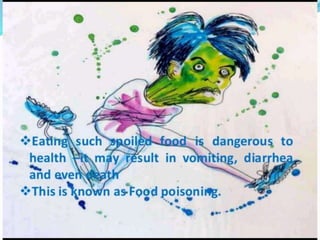


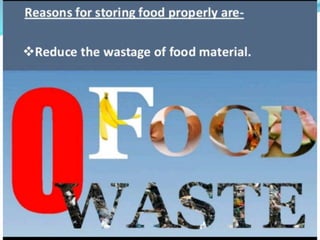
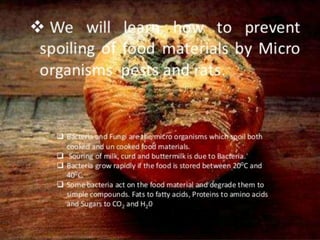

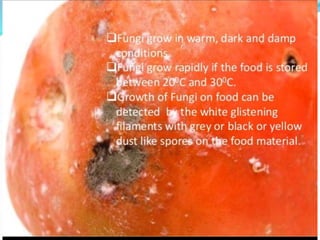
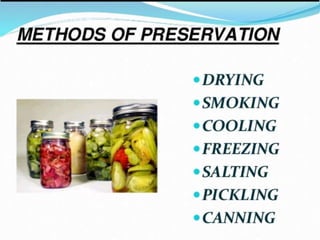

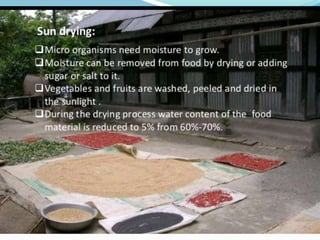
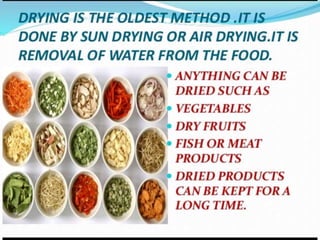
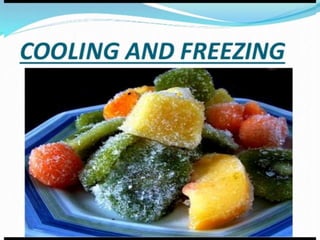
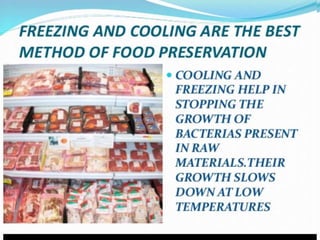


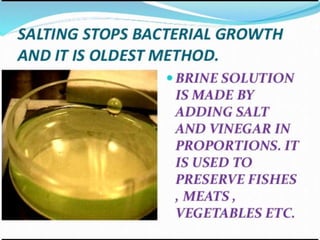



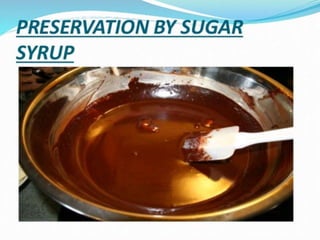

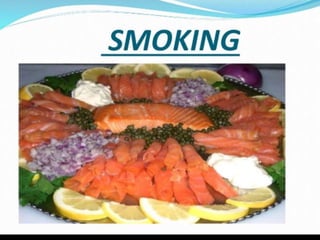
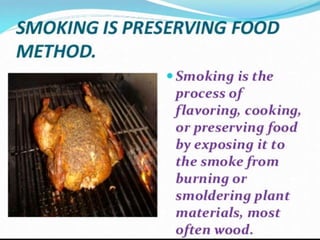
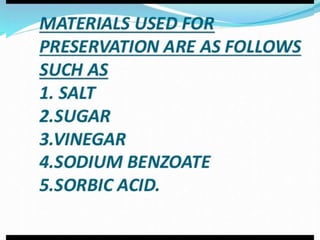
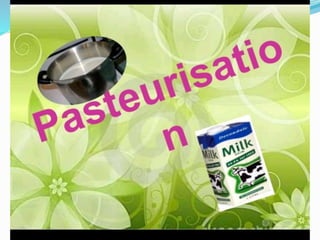
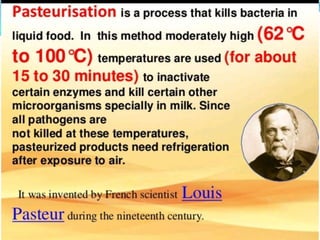


Ad
Recommended
Respiratory physiology
Respiratory physiologyprincipal phoenix paramedical college pulwama kashmir
Ã˝
The document discusses pulmonary function tests (PFTs) and the mechanics of breathing. It defines various lung volumes and capacities that are measured in PFTs, including tidal volume, vital capacity, functional residual capacity, and total lung capacity. It describes the processes of inspiration and expiration driven by the diaphragm and intercostal muscles. PFTs are used to evaluate pulmonary dysfunction, disease severity, and surgical risk. Spirometry measures volumes like FVC and FEV1, while plethysmography and gas dilution techniques measure total lung capacity and functional residual capacity.Structure and function of the respiratory tract in
Structure and function of the respiratory tract inprincipal phoenix paramedical college pulwama kashmir
Ã˝
The document summarizes the structure and function of the respiratory tract. It discusses how the nose humidifies inhaled air. It describes different types of airway obstructions like partial vs complete, and acute vs chronic obstructions. It discusses the roles of the pharynx, larynx, trachea, and bronchi in conducting air flow. It details the conducting and respiratory zones. It explains the layers of alveoli and role of surfactant in reducing surface tension.Cardiac procedure tray
Cardiac procedure trayprincipal phoenix paramedical college pulwama kashmir
Ã˝
The cardiac procedure tray contains various instruments used in open heart surgeries including retractors, forceps, scissors, clamps, and needle holders. Key items are the Himmelstein sternal retractor used to separate the sternum, various forceps and scissors for delicate tissue manipulation, mosquito clamps for hemostasis, and needle holders for suturing. Pean clamps are used for clamping larger tissues and vessels while Derra clamps specifically aid in cardiovascular anastomoses. The tray aims to provide the necessary tools to perform open heart procedures with precision.Face mask, airways,et tubes and laryngoscopes
Face mask, airways,et tubes and laryngoscopesprincipal phoenix paramedical college pulwama kashmir
Ã˝
This document discusses face masks, airways, laryngoscopes, endotracheal tubes, and extubation. Face masks are used for non-intubated ventilation and come in different sizes. Airways are inserted to prevent the tongue from falling back. Laryngoscopes are used to visualize the glottis and facilitate intubation, and come in different blade shapes like Macintosh and Miller. Endotracheal tubes are inserted into the trachea and come in different types and sizes. Extubation should be performed when respiration is adequate and during inspiration.Masks and its types
Masks and its typesprincipal phoenix paramedical college pulwama kashmir
Ã˝
Masks are important protective equipment used in healthcare. There are different types of masks used for various purposes like surgical masks, N95 masks, and oxygen masks. Each mask type has a specific use and function to provide protection or medical treatment in different situations.Food adulteration
Food adulterationprincipal phoenix paramedical college pulwama kashmir
Ã˝
This document discusses food adulteration. It was written by Umar Tariq, who has an MSc in OTT/Anaesthesia. In the document, Umar Tariq likely discusses issues related to food adulteration from his perspective as an expert with a medical background.Digestive system
Digestive systemprincipal phoenix paramedical college pulwama kashmir
Ã˝
The document summarizes the anatomy and physiology of the gastrointestinal tract. It describes the gastrointestinal tract as over 10 meters long, starting at the mouth and ending at the anus. It discusses the roles and structures of the mouth, teeth, tongue, esophagus, stomach, small intestine, large intestine, and associated accessory organs. It also outlines the main functions of the gastrointestinal tract as ingestion, digestion, absorption, and egestion.Normal dietary requirements and deficiency diseases of each
Normal dietary requirements and deficiency diseases of eachprincipal phoenix paramedical college pulwama kashmir
Ã˝
This document discusses energy and nutrient requirements, balanced diets, and meal planning. It states that carbohydrates, proteins, and fats provide energy, with carbohydrates recommended to supply 60-70% of daily energy needs. Meal planning should consider nutritional requirements, economic factors, food habits, and save time. Breakfast should provide over 25% of daily nutrients, with lunch and dinner making up the remainder.Water soluble vitamins(AGA UMAR)
Water soluble vitamins(AGA UMAR)principal phoenix paramedical college pulwama kashmir
Ã˝
Vitamins B1, B2, B3, B6, B5, B10, B12, biotin, bioflavonoids, and vitamin C are water-soluble vitamins that are not stored in the body and must be supplied through daily dietary intake. The document discusses the sources and functions of each vitamin, as well as recommended daily intake amounts. Key functions include roles in energy metabolism, cell growth and development, and resistance to infection.Minerals,water and vitamins( umar)
Minerals,water and vitamins( umar)principal phoenix paramedical college pulwama kashmir
Ã˝
This document discusses minerals, water, vitamins, and their roles and sources in the human body. It provides classifications of minerals based on their nature and requirements. It describes how water maintains fluid and electrolyte balance and is necessary for various bodily functions. It also outlines fat-soluble and water-soluble vitamins, listing specific vitamins in each group and their food sources and functions in the body.Minerals,water and vitamins
Minerals,water and vitaminsprincipal phoenix paramedical college pulwama kashmir
Ã˝
This document discusses minerals, water, and vitamins. It defines minerals as chemical elements required for growth, development, and biological processes. Minerals are classified based on their nature as alkali or acid forming, and whether they are major elements like calcium and phosphorus, or trace elements needed in small amounts like iron and zinc. Water makes up two thirds of the body, is involved in many processes, and is lost through excretion. Vitamins are organic compounds that act as catalysts but do not provide energy, with some being fat soluble like A, D, E, and K, and others water soluble like the B vitamins and vitamin C.Carbohydrates(AGA UMAR
Carbohydrates(AGA UMARprincipal phoenix paramedical college pulwama kashmir
Ã˝
Carbohydrates and fats are both major components of food. Carbohydrates include sugars, starches, and fiber found in foods like fruits, vegetables, grains, and are a main source of energy. They are classified as simple or complex based on their chemical structure. Fats are composed of fatty acids and carbon, hydrogen, and oxygen. Fats provide energy and help absorb vitamins. While animal fats tend to be saturated, vegetable oils are generally unsaturated. Both carbohydrates and fats are broken down and used by the body for energy or stored for later use.Proteins (UMAR TARIQ)
Proteins (UMAR TARIQ)principal phoenix paramedical college pulwama kashmir
Ã˝
The document discusses proteins, amino acids, and their importance for human nutrition and health. It notes that proteins are composed of amino acids, which are the building blocks of life. There are essential amino acids that must be obtained through food, as the body cannot synthesize them. The document lists the 9 essential amino acids and discusses non-essential and conditional amino acids. It also outlines the major sources of proteins from animal and plant sources, and the recommended daily intake of protein for Indians. Finally, it discusses the roles of proteins in the body and potential health issues from protein deficiency.Thoracotomy (AGA UMAR TARIQ)
Thoracotomy (AGA UMAR TARIQ)principal phoenix paramedical college pulwama kashmir
Ã˝
This document provides descriptions of various surgical instruments used in a thoracotomy procedure. It describes bone tools like a bone nibbler and rib shear for resection of ribs. It also outlines retractors like a rib spreader and lung retractor to access the thoracic cavity. Various forceps and clamps are explained like bronchial clamps, vascular tissue forceps, and lung holding forceps for grasping tissues and blood vessels. The document aims to inform about the key equipment used in opening the chest cavity during thoracic surgeries.Intraoperative care (AGA UMAR TARIQ)
Intraoperative care (AGA UMAR TARIQ)principal phoenix paramedical college pulwama kashmir
Ã˝
This document discusses intraoperative care during surgical procedures. Intraoperative care involves monitoring vital signs, fluid therapy, blood transfusions, anesthesia, and lab samples. The goals of intraoperative care are to maintain homeostasis, use strict sterile techniques to prevent infection, ensure the patient is securely positioned, and prevent burns from cautery. The surgical team works together, with specific sterile and non-sterile roles, to provide monitoring, emergency equipment and supplies, accurate counts, aseptic techniques, and skin preparation to keep the patient safe and comfortable during the operation.Nutrition ( AGA UMAR TARIQ)
Nutrition ( AGA UMAR TARIQ)principal phoenix paramedical college pulwama kashmir
Ã˝
This document discusses nutrition and food. It defines nutrition as the relationship between food and health. It explains that dietetics is the study of foods, their nutritional value, and requirements. Nutrients are divided into macronutrients and micronutrients. Macronutrients like proteins, carbohydrates, and fats provide calories and energy, while micronutrients like vitamins and minerals are required in smaller amounts. Food or diet is defined as a substance that provides materials for growth, reproduction, and resistance to disease when ingested. Food can be classified by origin, function, nutritive value, or chemical composition. The functions of food include providing energy, supporting life activities, body building and repair, tissue maintenanceOrthopaedic instrument trays
Orthopaedic instrument traysprincipal phoenix paramedical college pulwama kashmir
Ã˝
This document lists various surgical instruments and provides brief descriptions of their common uses. It includes forceps, retractors, needle holders, and other tools. Forceps include mosquito clamps for holding tissues, tissue forceps with and without teeth for grasping, and Adson forceps also with and without teeth. Retractors mentioned are skin hooks, Senn retractors, Volkmann retractors, and Weitlaner retractors for holding back tissue edges. Needle holders included are Olsen-Hegar with built-in scissors and Webster needle holders for suturing. Other instruments listed are towel clips for retraction, Allis clamps, and Frazier suction tips.Ether
Etherprincipal phoenix paramedical college pulwama kashmir
Ã˝
Ether was the first surgical anesthetic used in 1846. It has a strong, unpleasant smell and is highly flammable. While it provides analgesia, muscle relaxation, and narcosis, making it a complete anesthetic, it also causes increased secretions, nausea and vomiting. Ether induction is irritating and can cause laryngospasm. It has largely been replaced by safer modern inhalational anesthetics due to its flammability risks and undesirable side effects.Basic orthopaedic tray
Basic orthopaedic trayprincipal phoenix paramedical college pulwama kashmir
Ã˝
The document lists various orthopaedic surgical instruments including retractors, forceps, scissors, needle holders, towel clips, suction tips, knife handles, pliers, screw drivers, a mallet, ruler, depth gauge, guide wires, a rasp, drill handle, bone cutters, elevators, curettes, nerve hooks, Gigli saw, and osteotomes. It provides brief descriptions of the purpose and use of several of these instruments for procedures like bone graft harvesting, osteotomy, shaping bone surfaces, and attaching support plates.Breathing circuits
Breathing circuitsprincipal phoenix paramedical college pulwama kashmir
Ã˝
This document discusses different types of breathing circuits used in anesthesia. It begins by introducing open, semi-closed, and closed breathing circuits. Open circuits are now obsolete and involved pouring anesthetic agents over a mask. Semi-closed circuits include Mapelson circuits A-F, with Type D (Bain) most commonly used for controlled ventilation. Closed circuits involve rebreathing of exhaled gases after carbon dioxide absorption by soda lime, making them very economical. Key components and properties of soda lime and factors affecting its carbon dioxide absorption are described.Arterio venous (av) shunt tray
Arterio venous (av) shunt trayprincipal phoenix paramedical college pulwama kashmir
Ã˝
An arteriovenous shunt is a plastic tube inserted between an artery and vein, usually the radial artery and cephalic vein, to provide vascular access for hemodialysis. An AV shunt tray contains various retractors, forceps, scissors, clamps, and suction tips for performing vascular access procedures and dialysis port placement and maintenance. Common instruments included are Senn retractors for tissue retraction, Cushing retractors for nerve and vein manipulation, ALM self-retaining retractors for soft tissue retraction, carotid shunt clamps for blood flow occlusion, and vascular needle holders for suturing. Suction tips like the Frazier and Yankauer are also included for fluid removal.Monitoring aga umar
Monitoring aga umarprincipal phoenix paramedical college pulwama kashmir
Ã˝
This document discusses the importance of monitoring patients during anesthesia. It outlines the basic monitoring requirements which include having an anesthesiologist present, checking anesthesia equipment, and monitoring the patient. Both clinical and instrumental monitoring are described in detail, with arterial blood pressure, ECG, CVP, pulse oximetry, capnography, and temperature being some of the key instrumental monitors discussed. Normal ranges and indications for each monitor are provided.Cardiovascular trays
Cardiovascular traysprincipal phoenix paramedical college pulwama kashmir
Ã˝
This document lists various surgical instruments and provides brief descriptions of their uses. It includes forceps, retractors, clamps, needle holders and other tools commonly used in cardiovascular and thoracic surgical procedures. The instruments described are used for tasks like grasping tissues, retracting organs, occluding blood vessels, suturing, and other manipulation and handling of delicate structures.Pacemaker tray
Pacemaker trayprincipal phoenix paramedical college pulwama kashmir
Ã˝
The pacemaker tray contains various surgical instruments including retractors, forceps, scissors, and needle holders. Rake retractors are claw-shaped tools used to hold soft tissues during surgery. Stevens tenotomy scissors have long handles and small, sharp blades used for cutting membranes in procedures like ophthalmology and neurosurgery. Potts-Smith scissors have angled jaws between 25-90 degrees for trimming vessels in cardiac and thoracic surgeries. The tray is equipped for both general and specialized procedures.Mediastinoscopy
Mediastinoscopyprincipal phoenix paramedical college pulwama kashmir
Ã˝
This document lists the contents of a mediastinoscopy set, which includes various medical tools and supplies needed to perform a mediastinoscopy procedure such as a mediastinoscope, biopsy forceps, scalpel handle, Mayo scissors, suction tip, and bulldog clamps. It also includes sterile gowns, gloves, antiseptic solution, and other disposable supplies.Thoracotomy
Thoracotomyprincipal phoenix paramedical college pulwama kashmir
Ã˝
This document provides descriptions of various surgical instruments used in a thoracotomy procedure. It describes bone tools like a bone nibbler and rib shear for resection of ribs. It also outlines retractors like a rib spreader and lung retractor to access the thoracic cavity. Various forceps and clamps are explained like bronchial clamps, vascular tissue forceps, and lung holding forceps for grasping tissues and blood vessels. The document aims to inform about the key equipment used in opening the chest cavity during thoracic surgeries.Open prostatectomy tray
Open prostatectomy trayprincipal phoenix paramedical college pulwama kashmir
Ã˝
This document discusses prostatectomy procedures including simple and radical prostatectomy. Simple prostatectomy involves removing part of the prostate for benign conditions, while radical prostatectomy removes the entire prostate and surrounding tissues for prostate cancer. The document describes different approaches for radical prostatectomy including radical perineal, supra pubic, and retro pubic. Key instruments used in prostatectomy are also listed such as retractors, forceps, scissors, and hemoclip appliers.nanoparticle and liposomes ppt .(NTDS)pdf
nanoparticle and liposomes ppt .(NTDS)pdfsiddhikalbande
Ã˝
Nanoparticles and liposomes are advanced carriers used for targeted drug delivery.
Nanoparticles enhance drug effectiveness by directing treatment to specific sites.
Liposomes are biocompatible vesicles that enable controlled and sustained drug release.An interesting case of facial Swelling in an autoimmune rheumatic disease Ahm...
An interesting case of facial Swelling in an autoimmune rheumatic disease Ahm...Internal medicine department, faculty of Medicine Beni-Suef University Egypt
Ã˝
An interesting case of facial Swelling in an autoimmune rheumatic disease Ahmed Yehia EGYSIR Conference More Related Content
More from principal phoenix paramedical college pulwama kashmir (20)
Normal dietary requirements and deficiency diseases of each
Normal dietary requirements and deficiency diseases of eachprincipal phoenix paramedical college pulwama kashmir
Ã˝
This document discusses energy and nutrient requirements, balanced diets, and meal planning. It states that carbohydrates, proteins, and fats provide energy, with carbohydrates recommended to supply 60-70% of daily energy needs. Meal planning should consider nutritional requirements, economic factors, food habits, and save time. Breakfast should provide over 25% of daily nutrients, with lunch and dinner making up the remainder.Water soluble vitamins(AGA UMAR)
Water soluble vitamins(AGA UMAR)principal phoenix paramedical college pulwama kashmir
Ã˝
Vitamins B1, B2, B3, B6, B5, B10, B12, biotin, bioflavonoids, and vitamin C are water-soluble vitamins that are not stored in the body and must be supplied through daily dietary intake. The document discusses the sources and functions of each vitamin, as well as recommended daily intake amounts. Key functions include roles in energy metabolism, cell growth and development, and resistance to infection.Minerals,water and vitamins( umar)
Minerals,water and vitamins( umar)principal phoenix paramedical college pulwama kashmir
Ã˝
This document discusses minerals, water, vitamins, and their roles and sources in the human body. It provides classifications of minerals based on their nature and requirements. It describes how water maintains fluid and electrolyte balance and is necessary for various bodily functions. It also outlines fat-soluble and water-soluble vitamins, listing specific vitamins in each group and their food sources and functions in the body.Minerals,water and vitamins
Minerals,water and vitaminsprincipal phoenix paramedical college pulwama kashmir
Ã˝
This document discusses minerals, water, and vitamins. It defines minerals as chemical elements required for growth, development, and biological processes. Minerals are classified based on their nature as alkali or acid forming, and whether they are major elements like calcium and phosphorus, or trace elements needed in small amounts like iron and zinc. Water makes up two thirds of the body, is involved in many processes, and is lost through excretion. Vitamins are organic compounds that act as catalysts but do not provide energy, with some being fat soluble like A, D, E, and K, and others water soluble like the B vitamins and vitamin C.Carbohydrates(AGA UMAR
Carbohydrates(AGA UMARprincipal phoenix paramedical college pulwama kashmir
Ã˝
Carbohydrates and fats are both major components of food. Carbohydrates include sugars, starches, and fiber found in foods like fruits, vegetables, grains, and are a main source of energy. They are classified as simple or complex based on their chemical structure. Fats are composed of fatty acids and carbon, hydrogen, and oxygen. Fats provide energy and help absorb vitamins. While animal fats tend to be saturated, vegetable oils are generally unsaturated. Both carbohydrates and fats are broken down and used by the body for energy or stored for later use.Proteins (UMAR TARIQ)
Proteins (UMAR TARIQ)principal phoenix paramedical college pulwama kashmir
Ã˝
The document discusses proteins, amino acids, and their importance for human nutrition and health. It notes that proteins are composed of amino acids, which are the building blocks of life. There are essential amino acids that must be obtained through food, as the body cannot synthesize them. The document lists the 9 essential amino acids and discusses non-essential and conditional amino acids. It also outlines the major sources of proteins from animal and plant sources, and the recommended daily intake of protein for Indians. Finally, it discusses the roles of proteins in the body and potential health issues from protein deficiency.Thoracotomy (AGA UMAR TARIQ)
Thoracotomy (AGA UMAR TARIQ)principal phoenix paramedical college pulwama kashmir
Ã˝
This document provides descriptions of various surgical instruments used in a thoracotomy procedure. It describes bone tools like a bone nibbler and rib shear for resection of ribs. It also outlines retractors like a rib spreader and lung retractor to access the thoracic cavity. Various forceps and clamps are explained like bronchial clamps, vascular tissue forceps, and lung holding forceps for grasping tissues and blood vessels. The document aims to inform about the key equipment used in opening the chest cavity during thoracic surgeries.Intraoperative care (AGA UMAR TARIQ)
Intraoperative care (AGA UMAR TARIQ)principal phoenix paramedical college pulwama kashmir
Ã˝
This document discusses intraoperative care during surgical procedures. Intraoperative care involves monitoring vital signs, fluid therapy, blood transfusions, anesthesia, and lab samples. The goals of intraoperative care are to maintain homeostasis, use strict sterile techniques to prevent infection, ensure the patient is securely positioned, and prevent burns from cautery. The surgical team works together, with specific sterile and non-sterile roles, to provide monitoring, emergency equipment and supplies, accurate counts, aseptic techniques, and skin preparation to keep the patient safe and comfortable during the operation.Nutrition ( AGA UMAR TARIQ)
Nutrition ( AGA UMAR TARIQ)principal phoenix paramedical college pulwama kashmir
Ã˝
This document discusses nutrition and food. It defines nutrition as the relationship between food and health. It explains that dietetics is the study of foods, their nutritional value, and requirements. Nutrients are divided into macronutrients and micronutrients. Macronutrients like proteins, carbohydrates, and fats provide calories and energy, while micronutrients like vitamins and minerals are required in smaller amounts. Food or diet is defined as a substance that provides materials for growth, reproduction, and resistance to disease when ingested. Food can be classified by origin, function, nutritive value, or chemical composition. The functions of food include providing energy, supporting life activities, body building and repair, tissue maintenanceOrthopaedic instrument trays
Orthopaedic instrument traysprincipal phoenix paramedical college pulwama kashmir
Ã˝
This document lists various surgical instruments and provides brief descriptions of their common uses. It includes forceps, retractors, needle holders, and other tools. Forceps include mosquito clamps for holding tissues, tissue forceps with and without teeth for grasping, and Adson forceps also with and without teeth. Retractors mentioned are skin hooks, Senn retractors, Volkmann retractors, and Weitlaner retractors for holding back tissue edges. Needle holders included are Olsen-Hegar with built-in scissors and Webster needle holders for suturing. Other instruments listed are towel clips for retraction, Allis clamps, and Frazier suction tips.Ether
Etherprincipal phoenix paramedical college pulwama kashmir
Ã˝
Ether was the first surgical anesthetic used in 1846. It has a strong, unpleasant smell and is highly flammable. While it provides analgesia, muscle relaxation, and narcosis, making it a complete anesthetic, it also causes increased secretions, nausea and vomiting. Ether induction is irritating and can cause laryngospasm. It has largely been replaced by safer modern inhalational anesthetics due to its flammability risks and undesirable side effects.Basic orthopaedic tray
Basic orthopaedic trayprincipal phoenix paramedical college pulwama kashmir
Ã˝
The document lists various orthopaedic surgical instruments including retractors, forceps, scissors, needle holders, towel clips, suction tips, knife handles, pliers, screw drivers, a mallet, ruler, depth gauge, guide wires, a rasp, drill handle, bone cutters, elevators, curettes, nerve hooks, Gigli saw, and osteotomes. It provides brief descriptions of the purpose and use of several of these instruments for procedures like bone graft harvesting, osteotomy, shaping bone surfaces, and attaching support plates.Breathing circuits
Breathing circuitsprincipal phoenix paramedical college pulwama kashmir
Ã˝
This document discusses different types of breathing circuits used in anesthesia. It begins by introducing open, semi-closed, and closed breathing circuits. Open circuits are now obsolete and involved pouring anesthetic agents over a mask. Semi-closed circuits include Mapelson circuits A-F, with Type D (Bain) most commonly used for controlled ventilation. Closed circuits involve rebreathing of exhaled gases after carbon dioxide absorption by soda lime, making them very economical. Key components and properties of soda lime and factors affecting its carbon dioxide absorption are described.Arterio venous (av) shunt tray
Arterio venous (av) shunt trayprincipal phoenix paramedical college pulwama kashmir
Ã˝
An arteriovenous shunt is a plastic tube inserted between an artery and vein, usually the radial artery and cephalic vein, to provide vascular access for hemodialysis. An AV shunt tray contains various retractors, forceps, scissors, clamps, and suction tips for performing vascular access procedures and dialysis port placement and maintenance. Common instruments included are Senn retractors for tissue retraction, Cushing retractors for nerve and vein manipulation, ALM self-retaining retractors for soft tissue retraction, carotid shunt clamps for blood flow occlusion, and vascular needle holders for suturing. Suction tips like the Frazier and Yankauer are also included for fluid removal.Monitoring aga umar
Monitoring aga umarprincipal phoenix paramedical college pulwama kashmir
Ã˝
This document discusses the importance of monitoring patients during anesthesia. It outlines the basic monitoring requirements which include having an anesthesiologist present, checking anesthesia equipment, and monitoring the patient. Both clinical and instrumental monitoring are described in detail, with arterial blood pressure, ECG, CVP, pulse oximetry, capnography, and temperature being some of the key instrumental monitors discussed. Normal ranges and indications for each monitor are provided.Cardiovascular trays
Cardiovascular traysprincipal phoenix paramedical college pulwama kashmir
Ã˝
This document lists various surgical instruments and provides brief descriptions of their uses. It includes forceps, retractors, clamps, needle holders and other tools commonly used in cardiovascular and thoracic surgical procedures. The instruments described are used for tasks like grasping tissues, retracting organs, occluding blood vessels, suturing, and other manipulation and handling of delicate structures.Pacemaker tray
Pacemaker trayprincipal phoenix paramedical college pulwama kashmir
Ã˝
The pacemaker tray contains various surgical instruments including retractors, forceps, scissors, and needle holders. Rake retractors are claw-shaped tools used to hold soft tissues during surgery. Stevens tenotomy scissors have long handles and small, sharp blades used for cutting membranes in procedures like ophthalmology and neurosurgery. Potts-Smith scissors have angled jaws between 25-90 degrees for trimming vessels in cardiac and thoracic surgeries. The tray is equipped for both general and specialized procedures.Mediastinoscopy
Mediastinoscopyprincipal phoenix paramedical college pulwama kashmir
Ã˝
This document lists the contents of a mediastinoscopy set, which includes various medical tools and supplies needed to perform a mediastinoscopy procedure such as a mediastinoscope, biopsy forceps, scalpel handle, Mayo scissors, suction tip, and bulldog clamps. It also includes sterile gowns, gloves, antiseptic solution, and other disposable supplies.Thoracotomy
Thoracotomyprincipal phoenix paramedical college pulwama kashmir
Ã˝
This document provides descriptions of various surgical instruments used in a thoracotomy procedure. It describes bone tools like a bone nibbler and rib shear for resection of ribs. It also outlines retractors like a rib spreader and lung retractor to access the thoracic cavity. Various forceps and clamps are explained like bronchial clamps, vascular tissue forceps, and lung holding forceps for grasping tissues and blood vessels. The document aims to inform about the key equipment used in opening the chest cavity during thoracic surgeries.Open prostatectomy tray
Open prostatectomy trayprincipal phoenix paramedical college pulwama kashmir
Ã˝
This document discusses prostatectomy procedures including simple and radical prostatectomy. Simple prostatectomy involves removing part of the prostate for benign conditions, while radical prostatectomy removes the entire prostate and surrounding tissues for prostate cancer. The document describes different approaches for radical prostatectomy including radical perineal, supra pubic, and retro pubic. Key instruments used in prostatectomy are also listed such as retractors, forceps, scissors, and hemoclip appliers.Normal dietary requirements and deficiency diseases of each
Normal dietary requirements and deficiency diseases of eachprincipal phoenix paramedical college pulwama kashmir
Ã˝
Recently uploaded (20)
nanoparticle and liposomes ppt .(NTDS)pdf
nanoparticle and liposomes ppt .(NTDS)pdfsiddhikalbande
Ã˝
Nanoparticles and liposomes are advanced carriers used for targeted drug delivery.
Nanoparticles enhance drug effectiveness by directing treatment to specific sites.
Liposomes are biocompatible vesicles that enable controlled and sustained drug release.An interesting case of facial Swelling in an autoimmune rheumatic disease Ahm...
An interesting case of facial Swelling in an autoimmune rheumatic disease Ahm...Internal medicine department, faculty of Medicine Beni-Suef University Egypt
Ã˝
An interesting case of facial Swelling in an autoimmune rheumatic disease Ahmed Yehia EGYSIR Conference Clinical Signs Overview: PICCKLE Mnemonic
Clinical Signs Overview: PICCKLE MnemonicDr Aman Suresh Tharayil
Ã˝
This presentation provides a concise yet comprehensive review of common clinical signs and their diagnostic significance, summarized under the acronym PICCKLE – Pallor, Icterus, Clubbing, Cyanosis, Koilonychia, Lymphadenopathy, and Edema. Each condition is defined, followed by key causes, pathophysiology, diagnostic techniques, and clinical relevance. The content is tailored for undergraduate and postgraduate students in medicine and pharmacy, as well as early-career clinicians seeking to reinforce their clinical examination skillsAir Pollution, air quality index, Nepal air pollution
Air Pollution, air quality index, Nepal air pollutionDr. Anu Marhatta
Ã˝
This presentation slides is only for educational purposes. Special Education: Empowering Children Through Therapy andÃ˝Support
Special Education: Empowering Children Through Therapy andÃ˝SupportMyChildTherapy
Ã˝
Every child has unique learning abilities. Our Special Education program is designed to support children with learning disabilities, developmental delays, and cognitive challenges, ensuring they receive the individualized instruction needed to succeed in school and beyond.Anesthetic Evaluation & Management in Pregnancy with APH.pdf
Anesthetic Evaluation & Management in Pregnancy with APH.pdfDr Anik Roy Chowdhury
Ã˝
Dr. Anik Roy Chowdhury
MBBS, BCS (Health), DA, MD Resident
Shaheed Suhrawardy Medical College Hospital (ShSMCH)Coarse Dispersion, Physical Pharmaceutics
Coarse Dispersion, Physical Pharmaceuticsnishiprakashj
Ã˝
Its a compilation of unit 3 as per PCI syllabus of B.Pharm IV sem, Subject Physical Pharmaceutics.ANATOMY OF LARYNX -Prof.Dr.N.Mugunthan, KMMC.pdf
ANATOMY OF LARYNX -Prof.Dr.N.Mugunthan, KMMC.pdfKanyakumari Medical Mission Research Center, Muttom
Ã˝
Anatomy of the Larynx
Larynx is a cartilaginous structure located in the **anterior neck** at the level of **C3–C6 vertebrae**.
* Also called the **voice box**—responsible for **phonation**, **airway protection**, and **breathing regulation**.
**Cartilages of the Larynx**
**Unpaired Cartilages:**
1. **Thyroid cartilage**:
* Largest cartilage; forms the **Adam’s apple (laryngeal prominence)**.
* Composed of two laminae that fuse anteriorly.
2. **Cricoid cartilage**:
* Ring-shaped; **only complete ring** around the airway.
* Located below thyroid cartilage; articulates with thyroid & arytenoid cartilages.
3. **Epiglottis**:
* Leaf-shaped elastic cartilage.
* Covers the laryngeal inlet during swallowing.
**Paired Cartilages:**
1. **Arytenoid**:
* Pyramid-shaped; sit on top of cricoid.
* Attach vocal cords and muscles.
2. **Corniculate**:
* Small cartilages sitting atop the arytenoids.
3. **Cuneiform**:
* Embedded in the aryepiglottic folds; provide structural support.
**Intrinsic Muscles of the Larynx**
> Responsible for controlling **vocal cord movement**.
| Muscle | Action | Nerve Supply |
| **Cricothyroid** | Tenses vocal cords | External laryngeal nerve |
| **Thyroarytenoid** | Relaxes vocal cords | Recurrent laryngeal nerve |
| **Posterior cricoarytenoid** | Abducts vocal cords (opens glottis) | Recurrent laryngeal nerve |
| **Lateral cricoarytenoid** | Adducts vocal cords | Recurrent laryngeal nerve |
| **Transverse & oblique arytenoids** | Closes the posterior glottis | Recurrent laryngeal nerve |
| **Vocalis** | Fine-tunes pitch | Recurrent laryngeal nerve | **Nerve Supply*
* **Motor**:
* All intrinsic muscles (except cricothyroid): **Recurrent laryngeal nerve** (branch of vagus nerve).
* Cricothyroid: **External branch of superior laryngeal nerve**.
* **Sensory**:
* Above vocal cords: **Internal branch of superior laryngeal nerve**.
* Below vocal cords: **Recurrent laryngeal nerve**.
**Blood Supply**
* **Superior laryngeal artery** (branch of superior thyroid artery).
* **Inferior laryngeal artery** (branch of inferior thyroid artery).
**Laryngeal Cavity & Folds**
Divided into 3 regions:
1. **Vestibule** – from inlet to vestibular folds (false cords).
2. **Ventricle** – between vestibular and vocal folds.
3. **Infraglottic cavity** – below vocal cords to trachea.
**Vocal folds (true cords)** – involved in sound production.MASLD 2025 : A Case Based discisson by Dr. Om J Lakhani
MASLD 2025 : A Case Based discisson by Dr. Om J LakhaniDrOmLakhani1
Ã˝
Handcrafted medical presentation by Dr. Om J Lakhani
Have one of your own on DrPPT.inGlobal Harmonization Task Force (GHTF) and International Medical Device Regul...
Global Harmonization Task Force (GHTF) and International Medical Device Regul...Arpan Das
Ã˝
The Global Harmonization Task Force (GHTF) was a partnership between regulatory authorities and the medical device industry.Ã˝It was established in 1992 to improve patient safety and increase access to medical technologies.
The GHTF was replaced by the International Medical Devices Regulators Forum (IMDRF) in 2012. These devices vary widely in type and are highly essential for patient‚Äôs care, their manufacture, distribution, and sale must be regulated to ensure their quality, safety,Ã˝andÃ˝efficacy.Aspirin powder or Acetyl salicylic acid powder.docx
Aspirin powder or Acetyl salicylic acid powder.docxkopalsharma85
Ã˝
pharmacy exercise on aspirin powderKERATOCONUS- CLINICAL TOPIC PRESENTATION
KERATOCONUS- CLINICAL TOPIC PRESENTATIONDrSanjanaBhandari
Ã˝
Keratoconus clinical profile, diagnosis and managementTuberculosis burden , case finding tools and management .pptx
Tuberculosis burden , case finding tools and management .pptxDr. Anu Marhatta
Ã˝
This presentation is for educational purposes only. ADA Releases 2025 Standards of Care for Diabetes
ADA Releases 2025 Standards of Care for DiabetesJohn Kriak
Ã˝
On December 9, 2024, the American Diabetes Association (ADA) released the Standards of Care in Diabetes - 2025, which outlines evidence-based guidelines for diagnosing and managing diabetes and prediabetes. These guidelines, based on the latest scientific research and clinical trials, cover treatment approaches for both adults and children. They also address strategies to prevent or slow the progression of type 2 diabetes and related health conditions, including obesity.
The updated standards include care recommendations designed to improve health outcomes. The ADA revises these guidelines annually through its Professional Practice Committee (PPC), which consists of experts from various fields including physicians, nurse practitioners, certified diabetes care and education specialists, registered dietitian nutritionists, pharmacists, and methodologists.
The Standards of Care in Diabetes - 2025 is available online as a supplement to the January 2025 issue of Diabetes Care. A mobile application compatible with iOS and Android devices, it offers the latest guidelines, interactive tables, and algorithms for quick reference.
The ADA, a voluntary health organization, has focused on diabetes research and public health for 84 years. With 136 million Americans affected by diabetes or prediabetes, the organization continues to support education, program development, and advocacy efforts.Quality by Design Tools in Pharmaceutical Manufacturing Technology
Quality by Design Tools in Pharmaceutical Manufacturing Technology39KomalZaveri
Ã˝
In Qbd why risk assessment needed that explained
Design Space and DoE relationship with each other.
Tuberculosis Nepal 2025 National Plan.pptx
Tuberculosis Nepal 2025 National Plan.pptxDr. Anu Marhatta
Ã˝
The presentation contains preventive therapy, the DOTS program, and the national program of Nepal. This material is intended for educational purposes only.Viddha karma in Ayurveda-Dr Mahesh Kumar.pdf
Viddha karma in Ayurveda-Dr Mahesh Kumar.pdfCBPACS, Khera Dabar, Najafgarh New Delhi- 73
Ã˝
Ayurveda have description of various treatment modalities. Viddhakarma is ayurvedic treatment method described in ancient ayurveda literature. Its actually a Vedhana karma.
Application of Viddha karma in clinical practice is now popular.Mastering the Review Article: Structure, Strategy & Success
Mastering the Review Article: Structure, Strategy & SuccessRajendra Dev Bhatt
Ã˝
A scoping search identified various types of review articles. For this training, most common types were selected, highlighting their key features, strengths, weaknesses, and uses.clinical approach to a woman with gynecological problem.ppt
clinical approach to a woman with gynecological problem.pptFaculty of Medicine
Ã˝
clinical approach to a woman with gynecological problemAn interesting case of facial Swelling in an autoimmune rheumatic disease Ahm...
An interesting case of facial Swelling in an autoimmune rheumatic disease Ahm...Internal medicine department, faculty of Medicine Beni-Suef University Egypt
Ã˝
ANATOMY OF LARYNX -Prof.Dr.N.Mugunthan, KMMC.pdf
ANATOMY OF LARYNX -Prof.Dr.N.Mugunthan, KMMC.pdfKanyakumari Medical Mission Research Center, Muttom
Ã˝
Ad
